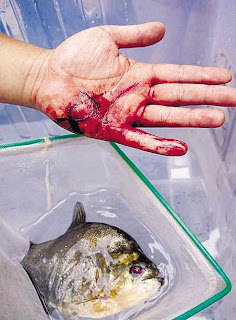While piranhas top out at about 2 feet (60 cm), most are about 8
inches (20 cm) from head to tail and weigh just a few pounds. The most
vicious of the roughly 20 species found in the Amazon River, the red-bellied piranha(Pigocentrus naterreri), is on the small end of the spectrum and usually weighs about 3 pounds. The next most aggressive species is the black piranha (Serrasalmus rhombeus), which tend to be bigger than red-bellies.
In the case of piranhas, it's not the size that counts. It's the teeth.
A
piranha's teeth are only about a quarter-inch (4 mm) long, but they're
like razors, and the whole jaw mechanism is designed for chomping
efficiency. The teeth are spaced in an interlocking pattern, so when a
piranha jaw snaps shut, the top teeth and the bottom teeth interlace
like dozens of razor-sharp scissors. The jaws are incredible strong:
Some people who have lost toes to piranhas have actually lost the entire
toe, bone included.
The reason why piranhas can strip a large
animal like a cow down to a skeleton so quickly is because of a few
factors. First, piranhas don't chew. When they bite down, the big chunk
of flesh they take out of the cow goes right into their bellies.
In a feeding frenzy, they rotate continuously, so as each piranha takes a
bite, it moves out of the way so the piranha behind it can get a bite,
and so on. They take turns with incredible speed, which is where the
boiling-water effect comes from. The piranhas are constantly changing position during a feeding frenzy.










No comments:
Post a Comment